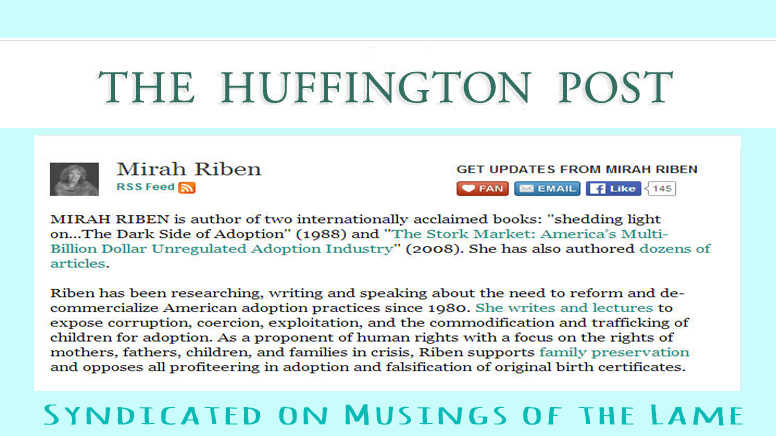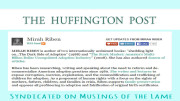By Mirah Riben
Sheena and Tiara Yates, a New Jersey couple and parents of two, are challenging the visitation rights of the biological father of their second child. It will be interesting to see if the courts, in deciding this case, will base their decision solely on the legal rights of the parents, or if they take into account the rights and best interest of the child created.
The Yates’ child was conceived privately for the lesbian couple with a sperm donor who signed a legal contract terminating his parental rights. The law in New Jersey, however, upholds third party reproductive contracts only when the insemination is conducted in a medical facility, and this conception occurred privately.
The law is the same for heterosexual married couples as it is for same sex couples, with one hitch. Parental right laws are based on the assumption of the husband being the father of all children produced during the marriage. While some states — including New Jersey — allow for exceptions with proof of paternity, in the case of lesbian conception, that exception is null.
Concern has been raised that laws requiring the use of a medical facility for conception unfairly discriminate against those who cannot afford such professional medical assistance, or simply are unaware of the law.
C. Catherine Swett, Esquire, Board of Directors, International Children’s Rights Institute, Northridge, California, believes the more important issue is that, “the child should be entitled to the parenting, support and acculturation of all parents regardless of where the conception takes place.”
Gay rights activists claim that biological fathers, such as the unnamed one in this case, are simply using a loophole in the law to interfere. John Culhane, writing about the case for Slate, calls such fathers “third-party interlopers.”
Tens of thousands of donor-created offspring who are searching to know their siblings and biological fathers, however, belie the concept of “interloper.” The number of registrants to the Donor Sibling Registry (DSR) has been growing since its inception and as of this writing, the DSR website claims 45,499 members, including donors, parents and donor-conceived people.
Additionally, Ken Daniels and Wendy Kramer, authors of “Genetic and Health Issues Emerging from Sperm Donation — The Experiences and Views of Donors” found that, “overall, donors indicate that they see donating as involving responsibilities to the offspring and families.”
In who’s best interest?
In divorce, custody and visitation are based on the right and best interest of the child to know, and have access to, both parents baring a finding of unfitness. Family courts favor liberal visitation. It is, in fact, illegal to withhold or impede visitation of a non-custodial parent. Even when there is a question of safety for the child, courts will order supervised visitation.
The right of visitation in divorce applies no matter the length of the marriage, even if the couple divorced before the birth of the child. Thus, visitation is not based on the length or depth of the social relationship.
Laws regulating the purchase of sperm, egg or frozen embryos do not follow the divorce paradigm, however. Instead, they follow the model of adoption in which the original, genetic, familial relationship is permanently severed in order to create a new one, disregarding the principal that children deserve to know (all) their parents.
In adoption, the original parents lose all parental rights either voluntarily or involuntarily. They are not non-custodial parents, but rather are legally deemed strangers to the children they bore. Adoptive parents are the sole legal parents who make all decisions regarding the care of the child, including who may visit. It is important to note that non-court mandated visitation, as occurs in some open adoptions, does not change these facts.
In a time when infertility was a shame-filled secret, laws were created to obliterate and hide all evidence of the child having been born to someone other than the adoptive parents. Until the late twentieth century, those who adopted were encouraged not to tell their children they were adopted. To validate this lie, the original birth certificate is sealed and a new certificate is issued listing the adoptive parents as the parents of birth, with no indication of an adoption.
Adoption activists are appalled that that the lies and secrecy they have fought against for decades are being replicated in anonymous third party reproduction. While adoption alleges to be about finding homes for children in need, it has become a privatized multi-billion dollar industry which, like the infertility industry, caters to those who can pay dearly to obtain a child. In both adoption and assisted reproduction, the child is reduced to a possession, highly sought but not treated as an autonomous human being with rights.
Today, married couples who use anonymous third-party assisted conception likewise often choose to keep secrets despite the risk to their child who unknowingly provides false medical history to health care providers believing that the man who is raising them, is their biological father.
Adoption records were sealed, beginning in the 1930s, allegedly to protect adoptees from “stigma” at a time when birth certificates of children born to single mothers were stamped “illegitimate.” Today, adoption and birth records are allegedly kept sealed to protect birth parents from unwanted scrutiny. A review of the state laws, however, reveals that the major reason for secrecy was to protect the adoptive parents from the “intrusion” of birth parents, or blackmail. None of this justifies denying adopted persons their truth.
Now we are doing the same to present and future generations of donor-conceived persons. Rather than putting the needs of the offspring (who become adults) first and foremost, assisted reproduction laws are following an outdated child-as-commodity model with its prime goal to protect parental lies. Anonymous third party procreation and adoption are the only areas in which laws are enacted for the sole purpose of protecting secrets and lies.
Adoptees have been searching for their biological roots in an organized fashion since 1953. Adoptees, and their original parents as well as adoptive parents, continue to fight state by state to overturn the laws that keep them unknown to one another.
Attorney Harold Cassidy, who represented surrogate mother Mary Beth Whitehead in the NJ Supreme Court that changed NJ law regarding surrogate contracts, said in an email:
“It has always been the public policy [in NJ], and still is, that every child should have the opportunity to know, love, and build a relationship with both biological parents to the fullest extent possible… we do not legally sanction a plan in advance of birth — and certainly not in advance of conception — to separate the child from one or both natural parents.”
“Nothing,” says Cassidy, “suggests that that policy should be disturbed.” This would include the forced separation of children and their genetic donor-parents.
Current adoption trends reflect an awareness of the negative, unhealthy impact of family secrets and lies, with the vast majority of domestic infant adoptions involving some level of openness ranging from the parties meeting before the birth to post-birth letters with or without photos, to birth parent visits with the child. It is thus backward to maintain such secrecy in reproductive assistance. States are changing the laws to allow adoptees access to their original birth certificate upon reaching majority age.
Swett, who is also founder and downstate coordinator of NY State Adoption Equalitytold me:
“Children born of ‘stranger assisted reproductive technologies’ have parent(s) who are strangers to the parent(s) who contract for their existence. The child should have no less right to know and be supported by these parents. We euphemistically call them donors and surrogates. The reality is they are sellers (of sperm and egg) and parents… biological flesh and blood parents and no contract should deny children their rights to their parent(s).”
The adoption industry has normalized the idea of coveting and obtaining the children of strangers and passing them off as “your own.” But parental rights issues — such as that of Sheena and Tiara Yates — should never be decided based on the rights of one (or two) parents versus another parent with the omission of the rights of the child to know their genetic heritage. Children are not property and decisions concerning their lives must not ignore their needs and rights.
Read at the Source: :


